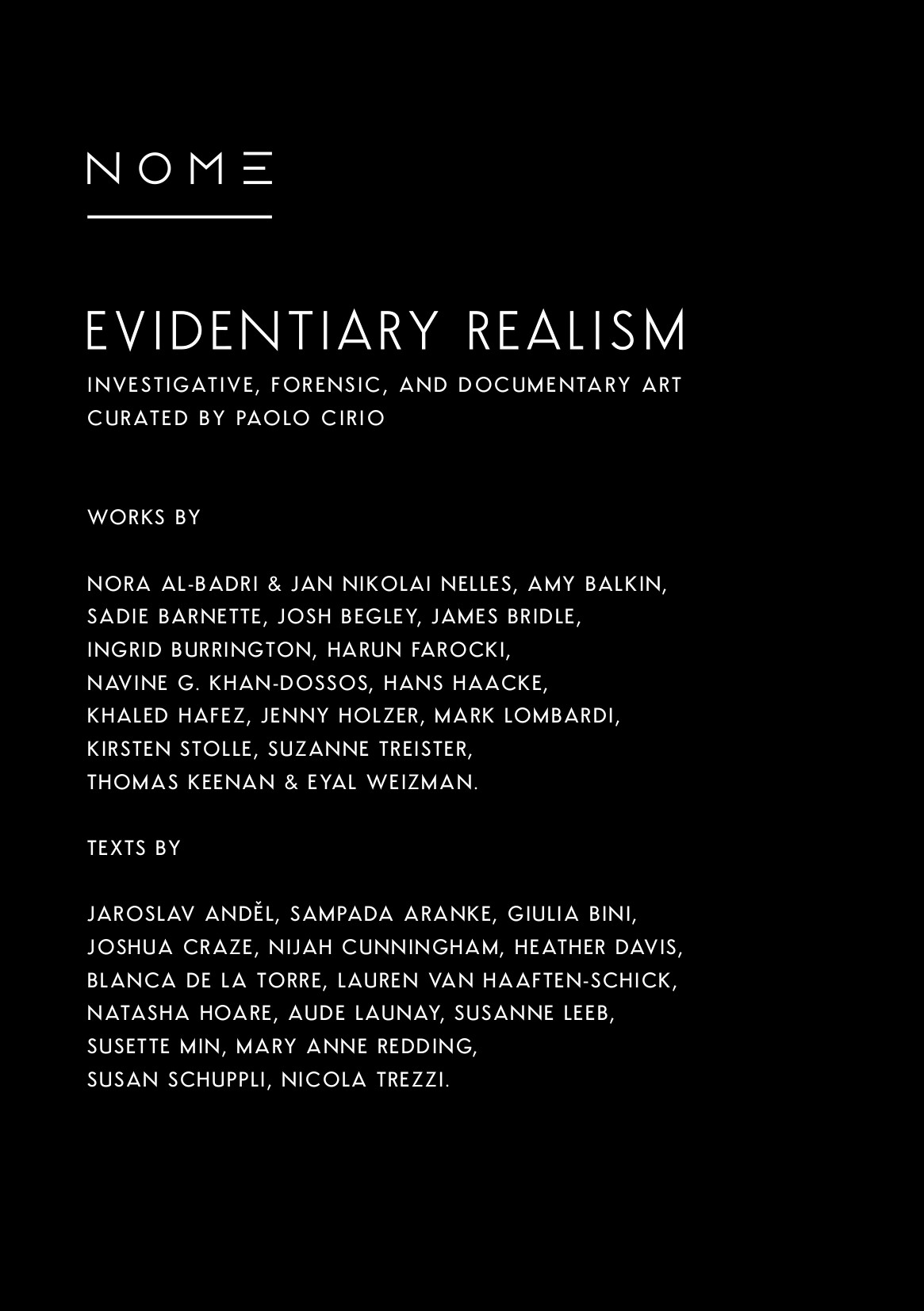Evidentiary Realism: Investigative, Forensic, and Documentary Art (2017)
Filed under catalogue | Tags: · art, corruption, documentary, forensics, human rights, journalism, politics, realism, surveillance, truth

“Evidentiary Realism aims to articulate a form of realism in art that portrays and reveals evidence from complex social systems. The truth-seeking artworks featured explore the notion of evidence and its modes of representation.
Evidentiary Realism reflects on post-9/11 geopolitics, increasing economic inequalities, the erosion of civil rights, and environmental disasters. It builds on the renewed appreciation of the exposure of truth in the context of the cases of WikiLeaks, Edward Snowden, the Panama Papers, and the recent efforts to contend with the post-factual era.”
The exhibition was held at Fridman Gallery, New York, 28 February-31 March 2017, and Nome Gallery, Berlin from 1 December 2017-17 February 2018.
Curated and organised by Paolo Cirio.
Artworks by Nora Al-Badri & Nikolai Nelles, Amy Balkin, Sadie Barnette, Josh Begley, James Bridle, Ingrid Burrington, Hans Haacke, Khaled Hafez, Jenny Holzer, Harun Farocki, Navine G. Khan-Dossos, Thomas Keenan & Eyal Weizman, Mark Lombardi, Kirsten Stolle, Suzanne Treister.
Texts by Jaroslav Anděl, Sampada Aranke, Giulia Bini, Nijah Cunningham, Heather Davis, Blanca de la Torre, Lauren van Haaften-Schick, Natasha Hoare, Aude Launay, Susanne Leeb, Susette Min, Mary Anne Redding, Susan Schuppli, and Nicola Trezzi.
Publisher NOME, Berlin, 2017
Creative Commons BY-NC-ND License
ISBN 9780244342739, 0244342733
171 pages
Project website
Curator, exh. reviews
WorldCat
Forensic Architecture (ed.): Forensis: The Architecture of Public Truth (2014)
Filed under book | Tags: · aesthetics, architecture, art, forensics, image, law, politics, theory, war

“Forensics originated from the term ‘forensis’ which is Latin for ‘pertaining to the forum.’ The Roman forum was a multidimensional space of negotiation and truth-finding in which humans as well as objects participated in politics, law, and the economy. With the advent of modernity, forensics shifted to refer exclusively to the courts of law and to the use of medicine, and today as a science in service to the law. The present use of forensics, along with its popular representations have become increasingly central to the modes by which states police and govern their subjects.
By returning to forensis this book seeks to unlock forensics’ original potential as a political practice and reorient it. Inverting the direction of the forensic gaze it designates a field of action in which individuals and organizations detect and confront state violations.
The condition of forensis is one in which new technologies for mediating the “testimony” of material objects—bones, ruins, toxic substances, landscapes, and the contemporary medias in which they are captured and represented—are mobilized in order to engage with struggles for justice, systemic violence, and environmental transformations across the frontiers of contemporary conflict.
This book presents the work of the architects, artists, filmmakers, lawyers, and theorists who participated directly in the “Forensic Architecture” project in the Centre for Research Architecture at Goldsmiths University of London, as well as the work of associates and guests. It includes forensic investigations undertaken by the project and its collaborators aimed at producing new kinds of evidence for use by international prosecutorial teams, political organizations, NGOs, and the UN. It also brings together research and essays that situate contemporary forensic practices within broader political, historical, and aesthetic discourse.”
With contributions by Lawrence Abu Hamdan, Nabil Ahmed, Maayan Amir, Hisham Ashkar & Emily Dische-Becker, Ryan Bishop, Jacob Burns, Howard Caygill, Gabriel Cuéllar, Eitan Diamond, DAAR (Decolonizing Architecture Art Residency), Anselm Franke, Grupa Spomenik, Ayesha Hameed, Charles Heller, Helene Kazan, Thomas Keenan, Steffen Krämer, Adrian Lahoud, Armin Linke, Jonathan Littell, Modelling Kivalina, Model Court, Working Group Four Faces of Omarska, Gerald Nestler, Godofredo Pereira, Nicola Perugini, Alessandro Petti, Lorenzo Pezzani, Cesare P. Romano, Susan Schuppli, Francesco Sebregondi, Michael Sfard, Shela Sheikh, SITU Research, Caroline Sturdy Colls, John Palmesino & Ann Sofi Ronnskog / Territorial Agency, Paulo Tavares, Füsun Türetken, Robert Jan van Pelt, Srdjan Jovanovic Weiss / NAO, Eyal Weizman, Ines Weizman, Chris Woods.
Publisher Sternberg Press, Berlin, and Forensic Architecture, London, 2014
ISBN 9783956790119, 3956790111
744 pages
Reviews: Léopold Lambert (The New Inquiry, 2014), Martin Howse (Mute, 2014), Gaston Gordillo (Society and Space, 2015), John Beck (Radical Philosophy, 2015).
Exh. review: Harry Burke and Lucy Chinen (Rhizome, 2014).
Exhibition
Publisher
Publisher
WorldCat
PDF (22 MB, updated on 2021-1-6)
Comment (0)Henry Bond: Lacan at the Scene (2009)
Filed under book | Tags: · crime, criminology, film, forensics, photography, psychoanalysis, psychology

“What if Jacques Lacan–the brilliant and eccentric Parisian psychoanalyst–had worked as a police detective, applying his theories to solve crimes? This may conjure up a mental film clip starring Peter Sellers in a trench coat, but in Lacan at the Scene, Henry Bond makes a serious and provocative claim: that apparently impenetrable events of violent death can bemore effectively unraveled with Lacan’s theory of psychoanalysis than with elaborate, technologically advanced forensic tools. Bond’s exposition on murder expands and develops a resolutely Zizekian approach. Seeking out radical and unexpected readings, Bond unpacks his material utilizing Lacan’s neurosis-psychosis-perversion grid.
Bond places Lacan at the crime scene and builds his argument through a series of archival crime scene photographs from the 1950s–the period when Lacan was developing his influential theories. It is not the horror of the ravished and mutilated corpses that draws his attention; instead, he interrogates seemingly minor details from the everyday, isolating and rephotographing what at first seems insignificant: a single high heeled shoe on a kitchen table, for example, or carefully folded clothes placed over a chair. From these mundane details he carefully builds a robust and comprehensive manual for Lacanian crime investigation that can stand beside the FBI’s standard-issue Crime Classification Manual.”
With a Foreword by Slavoj Zizek
Publisher MIT Press, 2009
Short Circuits series
ISBN 0262300095, 9780262300094
233 pages
Review: Daniel Hourigan (Metapsychology, 2010).
Comment (0)
